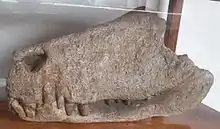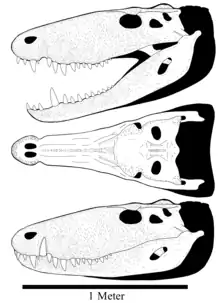| Barinasuchus | |
|---|---|
 | |
| Holotype fossil of Barinasuchus arveloi | |
| Scientific classification | |
| Domain: | Eukaryota |
| Kingdom: | Animalia |
| Phylum: | Chordata |
| Class: | Reptilia |
| Clade: | Archosauria |
| Clade: | Pseudosuchia |
| Clade: | Crocodylomorpha |
| Suborder: | †Notosuchia |
| Clade: | †Sebecosuchia |
| Clade: | †Sebecia |
| Family: | †Sebecidae |
| Genus: | †Barinasuchus Paolillo and Linares, 2007 |
| Type species | |
| †Barinasuchus arveloi Paolillo and Linares, 2007 | |
Barinasuchus (meaning "Barinas crocodile," in reference to where the type material was found) is an extinct genus of sebecid mesoeucrocodylian. Its fossils have been found in middle Eocene-age rocks of the Divisadero Largo Formation of Argentina, middle Miocene-age rocks of the Ipururo Formation of Peru, and middle Miocene-age rocks of the Parángula Formation of Venezuela.[1]
Description
Barinasuchus was described in 2007 by Alfredo Paolillo and Omar Linares.[2] The holotype comes from the rocks of the Parángula Formation, located in Barinas, Venezuela and consists of an incomplete, articulated skull. Like other sebecosuchians, it was a terrestrial carnivore equipped with ziphodont teeth, remarkably similar to those of theropods, which are compressed laterally, curved facing backwards, and with serrated borders. This dentition made it a formidable predator.

The preserved parts of the holotype consist of a skull that is 70 centimeters in length and 40 centimeters in height. Based on this, it is estimated that the total skull length was between 95 and 115 centimeters.[3] The total length of the animal is estimated to be close to 6 m (20 ft) based on more complete sebecosuchians like Stratiotosuchus,[3] making Barinasuchus the largest known sebecid. Without more complete remains, it is difficult to estimate its possible weight; however, based in the lengths of Stratiosuchus mexhechti and Crocodylus porosus, it has been estimated that Barinasuchus weighed around 1,610 and 1,720 kilograms respectively. This implies a superior weight than any of the large carnivoran mammals, and even considering a margin error of 50%, would still make it larger than any terrestrial mammalian predator of the Cenozoic.[3]
Fossils of the same age found in Peru previously assigned to Sebecus cf. huilensis were assigned to the type species, B. arveloi.[2]
Classification
In 2014, Diego Pol and his colleagues made a phylogenetic analysis, integrating many of the new genera and species found in the early 2010s. Compiling various phylogenetic studies in order to make a matrix that included 109 genera of Crocodyliforms, of which 412 morphological characteristics were studied. Notosuchia according to Diego Pol et al. includes 45 genera and 54 species.[4] In their cladogram, Barinasuchus is classified as a Sebecosuchian belonging to the family Sebecidae, close to the Lorosuchus genus and forms a sister taxon to the genera of Ayllusuchus and Bretesuchus, indicating that Barinasuchus belonged to a distant, basal lineage within the family.[4]

Cladogram based on the study done by Kellner et al. (2014), showing the position of Barinasuchus within Sebecosuchia.[5]
| |||||||||||||||||||||||||||||||||||||||||||||||||||||||||||||||||||||||||||||||||||||||||||
See also
References
- ↑ Barinasuchus at Fossilworks.org
- 1 2 Paolill A, Linares OJ (2007). "Nuevos cocodrilos Sebecosuchia del Cenozoico Suramericano (Mesosuchia: Crocodylia)" (PDF). Paleobiologia Neotropical (in Spanish). 3: 1–25. Archived from the original (PDF) on 2009-03-03. Retrieved 2009-02-15.
- 1 2 3 Molnar RE, de Vasconcellos FM (2016). "Cenozoic dinosaurs in South America – revisited". Memoirs of Museum Victoria. 74: 363–377. doi:10.24199/j.mmv.2016.74.25.
- 1 2 Pol D, Nascimento PM, Carvalho AB, Riccomini C, Pires-Domingues RA, Zaher H (2014-04-02). "A new notosuchian from the Late Cretaceous of Brazil and the phylogeny of advanced notosuchians". PLOS ONE. 9 (4): e93105. Bibcode:2014PLoSO...993105P. doi:10.1371/journal.pone.0093105. PMC 3973723. PMID 24695105.
- ↑ Kellner AW, Pinheiro AE, Campos DA (2014-01-15). "A new sebecid from the paleogene of Brazil and the crocodyliform radiation after the K-Pg boundary". PLOS ONE. 9 (1): e81386. Bibcode:2014PLoSO...981386K. doi:10.1371/journal.pone.0081386. PMC 3893294. PMID 24454686.
